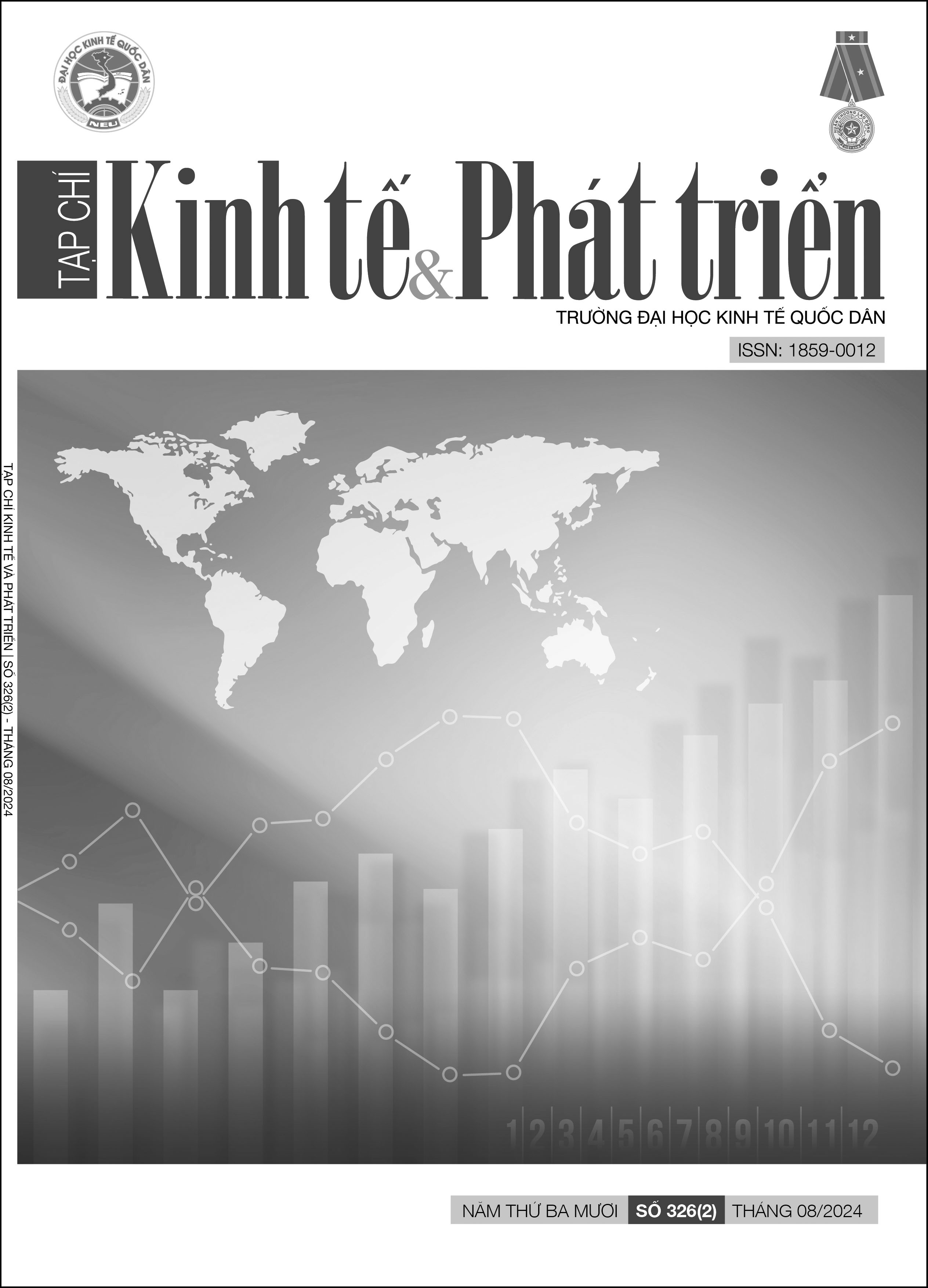Tác động của doanh nghiệp fintech tới sự ổn định của hệ thống ngân hàng thương mại Việt Nam
DOI:
https://doi.org/10.33301/JED.VI.1910Từ khóa:
Công nghệ tài chính, ngân hàng thương mại, ổn định hệ thống, rủi ro tín dụng, tỷ suất sinh lời trên tài sảnTóm tắt
Với mục tiêu đánh giá tác động của sự phát triển số lượng doanh nghiệp fintech tới sự ổn định của hệ thống Ngân hàng thương mại Việt Nam, bài báo sử dụng mô hình hồi quy tuyến tính dựa trên dữ liệu bảng theo năm của 26 Ngân hàng thương mại Việt Nam trong giai đoạn 2016-2022. Trong đó, biến phụ thuộc là sự ổn định của hệ thống Ngân hàng thương mại Việt Nam được đo lường bằng chỉ số Z-score, biến độc lập là số lượng các doanh nghiệp fintech, các biến kiểm soát gồm các biến đặc trưng của ngân hàng và các biến vĩ mô. Kết quả nghiên cứu cho thấy sự gia tăng số lượng doanh nghiệp fintech có tác động tích cực đến ổn định của hệ thống ngân hàng thương mại Việt Nam. Kết quả này có ý nghĩa trong việc đưa ra các khuyến nghị chính sách trong phát triển doanh nghiệp fintech nói chung và sự hợp tác giữa doanh nghiệp fintech với các ngân hàng thương mại nói riêng.
Tài liệu tham khảo
Ahamed, M. M., & Mallick, S. K. (2019), ‘Is financial inclusion good for bank stability?, International evidence’, Journal of Economic Behavior & Organization, 157, 403-427.
Allen. N., & Bouwman, C. H. (2013), ‘How does capital affect bank performance during financial crises?’, Journal of Financial Economics, 109(1), 146-176.
Athanasoglou, P. P., Brissimis, S. N., & Delis, M. D. (2008) ‘Bank-specific, industry specific and macroeconomic determinants of bank profitability’, Journal of international financial Markets, Institutions and Money, 18(2), 121-136.
Beck, T., Hesse, H., Kick, T. & Westernhagen, N. (2009), ‘Bank Ownership and Stability: Evidence from Germany’, Bundesbank Working Paper Series.
Berger, A. N., Hanweck, G. A. & Humphrey, D. B. (1987), ‘Competitive Viability in Banking: Scale, Scope, and Product Mix Economies’, Journal of Monetary Economics, 20, 501-520.
Berger, A. N. & Humphrey, D. B. (1997), ‘Efficiency of Financial Institutions: International Survey and Directions for Future Research’, European Journal of Operational Research, 98, 175-212.
Berger, A. N., & Bouwman, C. H. (2013), ‘How does capital affect bank performance during financial crises?’, Journal of Financial Economics, 109(1), 146-176.
Chronopoulos, D. K., Liu, H., McMillan, F. J., & Wilson, J. O. (2015), ‘The dynamics of US bank profitability’, The European Journal of Finance, 21(5), 426-443.
Comley, P. (2015), Inflation Matters: Inflationary Wave Theory, its impact on inflation past and present and the deflation yet to come, CreateSpace Independent Publishing Platform.
Creel, J., Hubert, P., & Labondance, F. (2015), ‘Financial stability and economic performance’, Economic Modelling, 48, 25-40.
De Jonghe, Olivier (2010), ‘Back to the basics in banking? A micro-analysis of banking system stability’, Journal of Financial Intermediation, 19(3), 387-417.
Dell’Ariccia, G., Igan, D., & Laeven, L. U. (2012), ‘Credit booms and lending standards: Evidence from the subprime mortgage market’, Journal of Money, Credit and Banking, 44(2‐3), 367-384.
Đinh Thị Thu Hồng & Nguyễn Hữu Tuấn (2021), ‘Tác động của fintech tới hiệu quả hoạt động của NHTM’, Tạp chí Thị trường Tài chính Tiền tệ, 1-2, 51-58.
Geanakoplos, J. (2010), ‘The leverage cycle’, NBER Macroeconomics Annual, 24(1), 1-66.
Honohan, P. (2008), ‘Cross-country variation in household access to financial services’, Journal of Banking & Finance, 32(11), 2493-2500.
Isik, O., Kosaroglu, Ş. M., & Demirci, A. (2018), ‘The impact of size and growth decisions on Turkish banks’ profitability’, International Journal of Economics and Financial Issues, 8(1), 21-29.
Imbierowicz, B., & Rauch, C. (2014), ‘The relationship between liquidity risk and credit risk in banks’, Journal of Banking & Finance, 40, 242-256.
Levine, Ross (2002), ‘International Financial Liberalization and Economic Growth’, Review of International Economics, 9(4), 688-702. DOI: https://doi.org/10.1111/1467-9396.00307.
Kosmidou, K. (2008), ‘The determinants of banks' profits in Greece during the period of EU financial integration’, Managerial Finance, 34(3), 146-159. DOI: 10.1108/03074350810848036.
Le Chi, Ha Van Dung & Nguyen Thi Minh Chau (2020), ‘The Threshold for the Efficient Scale of Vietnamese Commercial Banks: A Study Based on Bayesian Model’, In Data Science for Financial Econometrics, 531-542. DOI: 10.1007/978-3-030-48853-6_36.
Lee, C. C., Li, X., Yu, C. H., & Zhao, J. (2021), ‘Does fintech innovation improve bank efficiency? Evidence from China’s banking industry’, International Review of Economics & Finance, 74, 468–483.
Monika, A., Azam, A. N., & Teguh, S. I. (2021), ‘The impact of fintech development to profitability of Islamic bank’, International Journal of Research and Review, 8(1), 250-258.
Phan, D. H. B., Narayan, P. K., Rahman, R. E., & Hutabarat, A. R. (2020), ‘Do financial technology firms influence bank performance?’, Pacific-Basin Finance Journal, 62, 101210. DOI: https://doi.org/10.1016/j.pacfin.2019.101210.
Safiullah, M. & Paramati, S. R. (2022), ‘The impact of FinTech firms on bank financial stability’, Electronic Commerce Research, 24, 453–475. DOI: https://doi.org/10.1007/s10660-022-09595-z.
Salas, V., & Saurina, J. (2002), ‘Credit risk in two institutional regimes: Spanish commercial and savings banks’, Journal of Financial Services Research, 22(3), 203-224. DOI: https://doi.org/10.1023/A:1019781109676.
Willesson, M. (2015), ‘Risk and Efficiency in European Banking — Does Corporate Governance Matter?’, In Beccalli, E. & Poli, F. (eds), Bank Risk, Governance and Regulation. Palgrave Macmillan Studies in Banking and Financial Institutions, Palgrave Macmillan, London. DOI: https://doi.org/10.1057/9781137530943_6.





